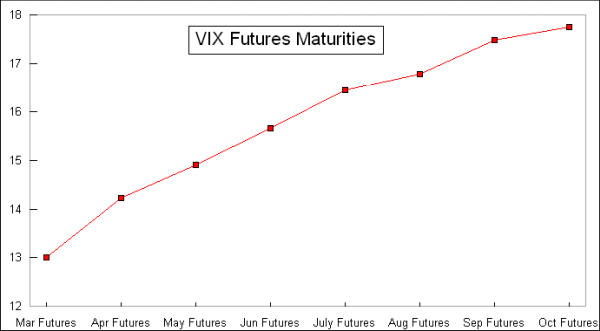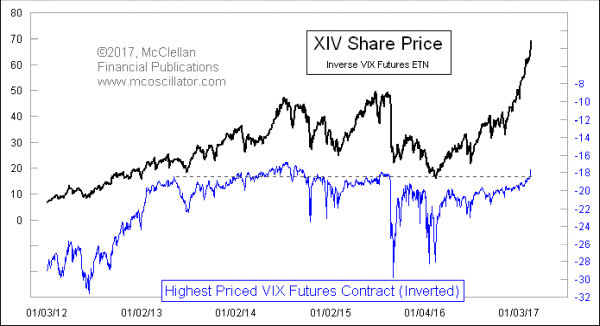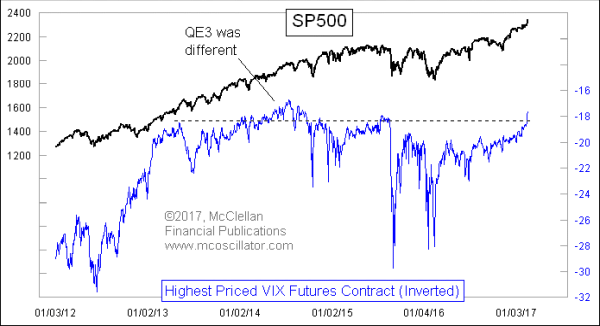The recent story about low readings for the spot VIX Index is well-reported. What has escaped the attention of many is that prices are now finally coming down for VIX futures at the long end of the maturity spectrum.
The spot VIX has been below 15 for most of the time since July 2016, except for a brief spike up to 22.51 on the Friday before the November 8, 2016 federal elections. Despite the spot VIX remaining low, the highest priced VIX futures contracts have been fairly steadily above 20. Usually the highest priced contracts are the farthest out expiration month contracts. Just recently, they started creeping lower, down into the 19s, then the 18s.
Something different is happening now. The current far-month contract is Oct. 2017, which closed on Feb. 15 at 17.675. That is the lowest number for the highest VIX futures contract since August 2015, just before the China-fueled mini-crash.
This week’s chart shows a plot depicting the value of the highest priced VIX futures contract over time. The prices are inverted to better align with the price action. Instances with the highest priced VIX futures contract being below 18 are pretty rare, and usually associated with meaningful tops. That “rule” did not work during QE3, but it is fair to say that a lot of things did not work then. The rule started working again after QE3 was ended.
You have probably heard of the several VIX related ETNs that are available now. Some folks do not know that those products are not actually tied to the spot VIX, but rather they own VIX futures, either long or short depending on the type of ETN. A big winner this year is XIV, the short VIX futures ETN, which has more than doubled since the November elections. XIV goes short the two VIX futures contracts nearest to expiration. It has a nice upward bias because of the natural time-decay of VIX futures pricing.
Here is what that term structure looks like as of Feb. 16, 2017:

So if you were the portfolio manager of XIV, most of the time you are exiting a lower priced near month contract, and re-shorting a higher priced later contract. You’d be repeating that process every month, creating a natural upward bias to the share price. Shareholders of XIV get to benefit from that contango, most of the time. It is a wonderful thing, in a stock market uptrend.
Occasionally, though, a real market panic sets in and pushes up the prices for VIX futures in a big way, in addition to pushing up the spot VIX. When that happens, XIV share prices fall, and no amount of harvesting contango at the expiration roll can make up for that. As an example, XIV plunged with the August 2015 China-induced minicrash, and ended up falling by 68% from the August 2015 high to the February 2016 low. If you had held onto your XIV shares for the long run, you’d have more than made that back. But hanging on through a 68% drawdown is a tough task for most people.
So how can we know when a drawdown event like that is likely to happen? The answer lies in looking at the prices for the farther out VIX futures contracts. When they are at high prices (low postings on the first chart), there is room for those prices to fall, and there is bearish sentiment to harvest. That is when XIV tends to do the best.
But when the highest priced VIX futures are at a low level, there is not much to harvest, and there is great risk of an adverse movement by VIX futures prices. We are in such a condition now.
Here is a chart showing that same plot of the highest priced VIX futures contract, this time compared to the share price of XIV. Notice that when the plot of the highest priced VIX futures contract (inverted) gets up this high, that is not a good time to be invested in XIV, and the risk of a big move downward increases in a big way.

This is not to disparage XIV as a great trading tool (different from an investing tool). Anything that can double in 3 months merits our respect. But it also deserves appropriate fear and avoidance when the wrong conditions prevail.
The spot VIX has been below 15 for most of the time since July 2016, except for a brief spike up to 22.51 on the Friday before the November 8, 2016 federal elections. Despite the spot VIX remaining low, the highest priced VIX futures contracts have been fairly steadily above 20. Usually the highest priced contracts are the farthest out expiration month contracts. Just recently, they started creeping lower, down into the 19s, then the 18s.
Something different is happening now. The current far-month contract is Oct. 2017, which closed on Feb. 15 at 17.675. That is the lowest number for the highest VIX futures contract since August 2015, just before the China-fueled mini-crash.
This week’s chart shows a plot depicting the value of the highest priced VIX futures contract over time. The prices are inverted to better align with the price action. Instances with the highest priced VIX futures contract being below 18 are pretty rare, and usually associated with meaningful tops. That “rule” did not work during QE3, but it is fair to say that a lot of things did not work then. The rule started working again after QE3 was ended.
You have probably heard of the several VIX related ETNs that are available now. Some folks do not know that those products are not actually tied to the spot VIX, but rather they own VIX futures, either long or short depending on the type of ETN. A big winner this year is XIV, the short VIX futures ETN, which has more than doubled since the November elections. XIV goes short the two VIX futures contracts nearest to expiration. It has a nice upward bias because of the natural time-decay of VIX futures pricing.
Here is what that term structure looks like as of Feb. 16, 2017:

So if you were the portfolio manager of XIV, most of the time you are exiting a lower priced near month contract, and re-shorting a higher priced later contract. You’d be repeating that process every month, creating a natural upward bias to the share price. Shareholders of XIV get to benefit from that contango, most of the time. It is a wonderful thing, in a stock market uptrend.
Occasionally, though, a real market panic sets in and pushes up the prices for VIX futures in a big way, in addition to pushing up the spot VIX. When that happens, XIV share prices fall, and no amount of harvesting contango at the expiration roll can make up for that. As an example, XIV plunged with the August 2015 China-induced minicrash, and ended up falling by 68% from the August 2015 high to the February 2016 low. If you had held onto your XIV shares for the long run, you’d have more than made that back. But hanging on through a 68% drawdown is a tough task for most people.
So how can we know when a drawdown event like that is likely to happen? The answer lies in looking at the prices for the farther out VIX futures contracts. When they are at high prices (low postings on the first chart), there is room for those prices to fall, and there is bearish sentiment to harvest. That is when XIV tends to do the best.
But when the highest priced VIX futures are at a low level, there is not much to harvest, and there is great risk of an adverse movement by VIX futures prices. We are in such a condition now.
Here is a chart showing that same plot of the highest priced VIX futures contract, this time compared to the share price of XIV. Notice that when the plot of the highest priced VIX futures contract (inverted) gets up this high, that is not a good time to be invested in XIV, and the risk of a big move downward increases in a big way.

This is not to disparage XIV as a great trading tool (different from an investing tool). Anything that can double in 3 months merits our respect. But it also deserves appropriate fear and avoidance when the wrong conditions prevail.
Tom McClellan
Editor, The McClellan Market Report
Views:
